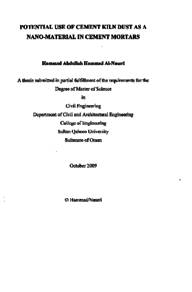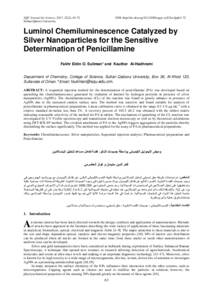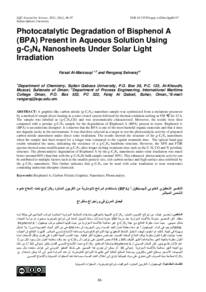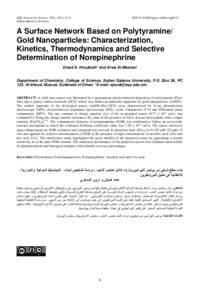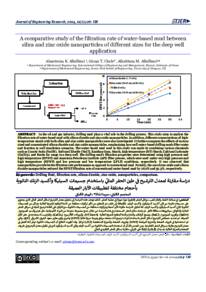Document
Potential use of cement kiln dust as a nano-material in cement mortars.
Publisher
Sultan Qaboos University
Gregorian
2009
Language
English
English abstract
This research was undertaken to study the effect of the milled or nano-sized cement kiln dust (CKD) addition on the properties of cement mortars and to characterize their physical, chemical, and microscopical features at the nano-scale. In addition to the control mixture, which consisted from bulk sized CKD (unmilled material), 28 mixtures were prepared using different proportions of CKD at 5, 10, 15, and 20%, replacement by total weight of ordinary Portland cement for different milling times of 1, 1.5, 2, 2.5, 3, 3.5, and 4 hours and under different curing periods of 7, 28, and 56 days. The influence of nano-CKD particles on the properties of hardened cement mortars were evaluated through the measurement of compressive strength and from the characterization of their microstructure using scanning electron microscope (SEM), transmission electron microscope (TEM) and X-ray diffraction (XRD). Overall results indicated that the compressive strengths increased by 15 to 30 % for almost all mixtures incorporating nano-CKD compared to the strength results obtained for the original control mixture. Moreover, it was observed that the initial setting time of fresh cement pastes were reduced after adding nano-CKD particles. SEM results indicated that the interface pores between cement and sand particles were filled and bonded with the addition of nano-CKD. In addition, results also showed that nano-CKD produced denser cement mortars by enhancing their mechanical strengths, especially after 28 days of curing.
Member of
Resource URL
Arabic abstract
يهدف هذا البحث لدراسة تأثير استخدام غبار فرن الأسمنت (CKD) ذو الأحجام الدقيقة جدا (مقياس النانو) في تحضير الهاونات لأسمنتية بالإضافة إلى دراسة خصائصها الفيزيائية والكيميائية وتحليل بعض خصائصها الأخرى بواسطة الأجهزة الميكروسكوبية إضافة إلى ليط القياس (المقارنة) والذي يتكون من خليط الحجم الأصلي لغبار فرن الأسمنت بدون تفتيت) ، تم تحضير نحو 28 من المزائج المختلفة لتي أعدت باستخدام نسب متفاوتة من غبار فرن الاسمنتت وهي 5، 10، 15، و 20 ٪ من مجموع الوزن العادي للاسمنت البورتلاندي عند أوقات تفتيت مختلفة وهي 1، 1 . 5، 2، 2 . 5، 3، 3 . 5، و 4 ساعات حسب فترات معالجه 7، 28 و 56 يوما. ثم تم دراسة تأثير هذه الجسيمات الدقيقة على خصائص معجون اسمنت غبار الفرن الرطب و خصائص هاونات الأسمنت عن طريق قياس زمن التصلب لأولي لمعجون اسمنت غبار الفرن وأيضا قياس مقاومة هاونات الأسمنت لقوة الضغط الأفقي (الغير محصور)، وكذلك تم فحص التكوينات الداخلية لهاونات الاسمنت بواسطة المجهر (الماسح الالكتروني). النتائج تشير إلى أن قوة مقاومة الضغط الأفقي للهاونات تحسنت بنحو 15 إلى 30 % مقارنة مع تلك التي تم الحصول عليها من نتائج الخليط الأصلي لذرات غبار الفرن. وعلاوة على ذلك، لوحظ انخفاض الزمن الأولي للتصلب لمعظم معاجين الاسمنت المحتوي على ذرات نانو-غبار الفرن. نتائج المسح الاليكتروني لهاونات الأسمنت المحتوية على ذرات نانو-غبار فرن الاسمنت أظهرت إنتاج هاونات إسمنتية أكثر صلابة وتماسكا وذلك لان ذرات نانو-غبار الاسمنت أدت إلى ملء وسد كل المسامات الموجودة بين مكوناتها الداخلية عند مقارنتها مع الهاونات الإسمنتية التي تحتوي على ذرات غبار الفرن الأصلية بالاضافة إلى ذلك أشارت نتائج الفحص المجهري (المسح الضوئي إلى إمكانية الحصول على عينات أسمنتية أكثر صلابة عند إضافة ذرات نانو-غبار فرن الاسمنت كبديل جزئي عن الاسمنت البورتلاندي العادي في تحضير خلطاتها وخاصة بعد عمر 28 يوم من المعالجة
Category
Theses and Dissertations

